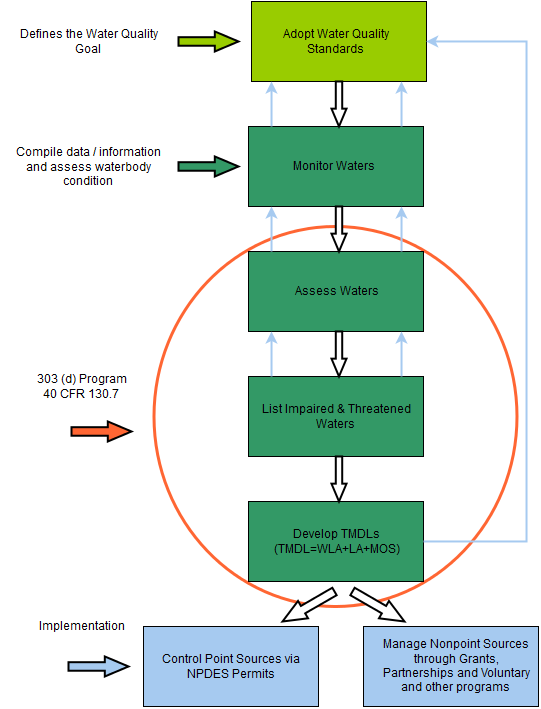Overview of Identifying and Restoring Impaired Waters under Section 303(d) of the CWA
The Impaired Waters and Total Maximum Daily Load (TMDL) Program is an important component of the Clean Water Act’s (CWA) framework to restore and protect our Nation’s waters. The program is comprised primarily of a two part process. First, states identify waters that are impaired or in danger of becoming impaired (threatened) and second, for these waters, states calculate and allocate pollutant reduction levels necessary to meet approved water quality standards.
What is Section 303(d) of the Clean Water Act?
The goal of the Clean Water Act (CWA) is "to restore and maintain the chemical, physical, and biological integrity of the Nation's waters" (33 U.S.C §1251(a)). Under section 303(d) of the CWA, states, territories and authorized tribes, collectively referred to in the act as "states," are required to develop lists of impaired waters. These are waters for which technology-based regulations and other required controls are not stringent enough to meet the water quality standards set by states. The law requires that states establish priority rankings for waters on the lists and develop Total Maximum Daily Loads (TMDLs) for these waters. A TMDL includes a calculation of the maximum amount of a pollutant that can be present in a waterbody and still meet water quality standards.
How does the 303(d) Impaired Waters and TMDL Program Fit into the Clean Water Act?
As part of the CWA, states must establish water quality standards (WQS) for waters within their borders. Such standards designate the use of the particular waterbody (e.g., recreation or protection of aquatic life), establish water quality criteria to protect the waterbody, and adopt requirements to protect and maintain healthy waters.
Water Quality-Based Approach of the Clean Water Act

Under Section 303(d) of the Act, states are required to evaluate all available water quality-related data and information to develop a list of waters that do not meet established WQS (impaired) and those that currently meet WQS, but may exceed it in the next reporting cycle (threatened). States then must develop a TMDL for every pollutant/waterbody combination on the list. An essential component of a TMDL is the calculation of the maximum amount of a pollutant that can occur in waterbody and still meet WQS. Within the TMDL the state allocates this loading capacity among the various point sources and non-point sources. Permits for point sources are issued through EPA’s National Pollutant Discharge Elimination System, or NPDES program.
States are required to update and resubmit their impaired waters list every two years. This process ensures that polluted waters continue to be monitored and assessed until applicable water quality standards are met.
